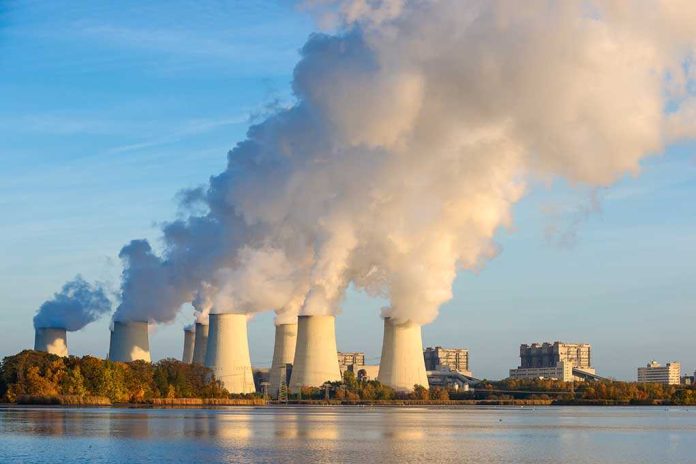
Pennsylvania’s historic Three Mile Island nuclear plant will reopen a year ahead of schedule, creating 3,400 jobs and injecting $16 billion into the state’s economy as Microsoft taps its clean energy for AI data centers.
Key Takeaways
- The Three Mile Island reactor, renamed Crane Clean Energy Center, will restart in 2027 (a year earlier than planned) after signing a 20-year power purchase agreement with Microsoft.
- The $1.6 billion project will create approximately 3,400 direct and indirect jobs and contribute $16 billion to Pennsylvania’s economy.
- The facility will add 835 megawatts to the power grid, enough to power 800,000 homes, meeting growing electricity demands from AI and data centers.
- This revival represents a strategic shift as tech giants increasingly turn to reliable nuclear energy, with U.S. electricity consumption from AI and data centers projected to increase 130% by 2030.
- The reactor has been offline since 2019 for economic reasons and is separate from Unit 2, which experienced the famous 1979 partial meltdown.
Nuclear Revival Meets AI Power Demand
The Three Mile Island nuclear reactor, now rebranded as the Crane Clean Energy Center, is powering up for a comeback that signals a major economic revival for Pennsylvania. Constellation Energy Corporation announced that the Unit 1 reactor, which has been offline since 2019 due to economic challenges, will restart operations in 2027—a full year ahead of the initially projected timeline. This accelerated schedule follows a crucial 20-year power purchase agreement with Microsoft, which will use the nuclear facility’s carbon-free energy to power its expanding network of data centers that support AI technologies.
The reopening represents a significant shift in America’s energy landscape as technology companies increasingly seek reliable, clean power sources. The Crane Clean Energy Center will generate 835 megawatts of electricity, enough to power approximately 800,000 homes. This massive energy production capability comes at a critical time, as experts project U.S. electricity consumption from AI and data centers to surge by 130% between 2024 and 2030, highlighting the growing intersection between nuclear energy and technological advancement.
Economic Boom for Pennsylvania
Constellation’s $1.6 billion investment in restarting the reactor is expected to create approximately 3,400 jobs, including both direct employment at the facility and indirect positions throughout the supply chain and local economy. The project’s impact extends far beyond immediate job creation, with projections suggesting it will contribute a staggering $16 billion to Pennsylvania’s gross domestic product over its operational lifetime. This economic infusion comes at a perfect time as the state works to strengthen its industrial base and attract high-tech investment.
“Pennsylvania is on the rise,” said Gov. Josh Shapiro. “Folks shouldn’t sleep on nuclear.”
Beyond the significant economic impact, Constellation has also committed to investing $1 million in the Harrisburg community over the next five years. This community investment underscores the company’s commitment to being a good corporate neighbor and acknowledges the important relationship between the facility and surrounding communities. Local leaders have widely praised the reactor’s reopening as a win for both the regional economy and America’s energy independence.
Nuclear Energy and America’s AI Future
The revival of Three Mile Island’s Unit 1 reactor highlights the growing importance of nuclear energy in powering America’s technological future. Microsoft’s decision to partner with Constellation represents part of a larger trend, as tech giants increasingly turn to nuclear power for their energy-intensive data centers. Constellation has struck a similar agreement with Meta Platforms to supply nuclear power from its Clinton Clean Energy Center in Illinois starting in 2027, demonstrating the tech industry’s growing reliance on nuclear energy’s reliability and carbon-free attributes.
“You wonder why I’m passionate about nuclear energy. My father … was here from the original build of Unit 1 and Unit 2, and as a kid, that plant put meals on my table, a roof over my head, clothes on my back. That would not have happened without nuclear energy,” said Rob Bair.
While approximately 18% of America’s power in 2024 is projected to come from nuclear energy, the sector’s importance is likely to grow as demands for reliable, carbon-free electricity continue to increase. The Crane Clean Energy Center’s reopening marks an important step in recognizing nuclear energy’s vital role in America’s energy future, particularly as artificial intelligence and other data-intensive technologies require ever-increasing amounts of electricity. This strategic revival demonstrates how traditional energy infrastructure can be repurposed to meet the demands of our technological future while creating thousands of good-paying American jobs.







